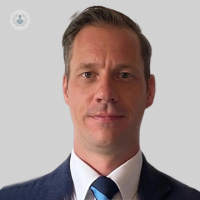Managing back and leg pain: What are your treatment options?
Written in association with:Back and leg pain are common complaints that affect people of all ages, often limiting daily activities and reducing quality of life. This type of discomfort can stem from a variety of causes, including muscle strain, disc problems, nerve compression, or even age-related wear and tear on the spine. Knowing your treatment options is essential for both relief and recovery, particularly if you’re seeking a solution that enables a quick return to your routine.
Esteemed consultant spinal surgeon Mr Paul Brewer explains treatment options for back and leg pain.

What non-surgical treatments are available?
Most cases of back and leg pain can be treated with conservative (non-surgical) methods. Initially, patients are often advised to try lifestyle modifications, which may include resting for short periods, avoiding heavy lifting, and maintaining good posture. Exercise and physiotherapy are also commonly recommended to improve flexibility and strengthen the muscles supporting the spine. Physical therapy exercises can target the lower back and leg muscles, alleviating pressure on affected areas and helping prevent future flare-ups.
Over-the-counter medications, such as ibuprofen or paracetamol, are frequently used to reduce pain and inflammation. If these are not sufficient, a doctor might suggest prescription medications, which can be more effective but may come with side effects. Another option is steroid injections, which deliver anti-inflammatory medication directly to the area around the nerves or joints. This approach may provide temporary relief and can be repeated periodically, depending on the patient’s response.
When is surgery recommended?
Surgery is typically considered only when conservative treatments have failed, or when the pain is due to specific conditions such as a herniated disc, spinal stenosis (narrowing of the spinal canal), or severe nerve compression. Surgery may also be recommended if there are signs of nerve damage, such as weakness, numbness, or loss of bladder control.
One of the most common types of surgery for back and leg pain is a discectomy, in which part of a herniated disc that is pressing on a nerve is removed. Another common procedure is spinal fusion, which involves connecting two or more vertebrae to stabilise the spine and alleviate pain caused by movement in damaged areas.
How quick is recovery after surgery?
Recovery from back surgery can vary depending on the type of procedure performed and the patient’s overall health. Thanks to advancements in minimally invasive surgical techniques, many patients experience shorter recovery times than in the past. Minimally invasive procedures require smaller incisions, meaning there is less damage to the surrounding muscles and tissues. This often results in reduced pain and faster healing, allowing patients to resume light activities within weeks.
In some cases, patients undergoing minimally invasive procedures may even be discharged the same day. However, it’s important to follow a tailored rehabilitation programme after surgery to ensure a full and lasting recovery. Physiotherapy and gradual exercise are essential to regain strength and flexibility while avoiding undue strain on the spine.
What can you do to prevent future pain?
Preventing back and leg pain involves a combination of lifestyle adjustments. Regular low-impact exercises, like walking or swimming, can strengthen the muscles that support your spine. Practising good posture and ergonomics, especially if you have a sedentary job, is also essential. In some cases, specific exercises targeting the core and back muscles can significantly reduce the risk of recurring pain.
If you are suffering from back and leg pain and would like to book a consultation with Mr Brewer, visit his Top Doctors profile today.


